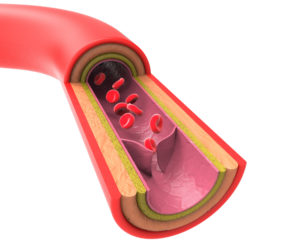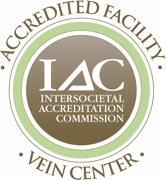Chronic venous insufficiency (CVI) is associated with a wide clinical spectrum ranging from cosmetic problems to severe symptoms, including ulceration. The incidence of this condition increases with age and is higher among woman than men. Chronic venous insufficiency worsens with pregnancy. The venous system of the lower limbs consists of an interconnected network of superficial veins, perforator veins and deep veins. The severity of symptoms tends to increase according to the number of systems affected. CVI is a very common condition resulting from decreased blood flow from the leg veins up to the heart, with pooling of blood in the veins. CVI is especially pronounced in the legs because veins in the legs are furthest from the heart and must work against gravity to get blood back to the chest.
Varicose veins are a symptom of venous insufficiency where prominent, elongated veins appear rope-like and bulging just under the skin’s surface.

The word varicose comes from the Latin root varix, which means “twisted”. Any vein in the body may become varicose, but the most common varicose veins occur near the skin surface in your legs. Only humans seem to be affected by this varicose veins, suggesting it is related to our upright posture. Throughout the day our legs remain in the dependent position (standing or sitting) which increases the pressure in the veins of our lower body due to gravity. This condition is usually caused by failure of the valves in these veins. Valves function by preventing the backward flow of blood, and when they do not work, they allow blood to pool in the leg veins, causing bulging veins and a number of different symptoms.
What is venous insufficiency?
Symptoms of Venous Insufficiency
Initially, venous insufficiency may not have any symptoms at all save the appearance of pronounced or even bulging veins in the legs. However, if the condition worsens, it can cause pain or discomfort, as well as an assortment of other symptoms. Some of these include:
- Leg heaviness and fatigue
- Swelling of the ankles and calves
- Itching of the skin around the veins
- Muscle cramps/Charlie horses
- Restless legs at night
- Skin discoloration or breakdown
Treatments for CVI
Elevating the legs, exercising, and wearing compression stockings may provide some relief from minor cases of venous insufficiency. You can also alleviate the pain somewhat by avoiding sitting or standing in one position for a long time to help prevent blood from pooling in the legs.
More serious chronic venous insufficiency may require medical intervention. Vein doctors prescribe several different treatment methods depending on the severity of the condition:
- Conservative treatment
- Medical grade graduated compression stockings
- A minimally-invasive procedure to effectively eliminate diseased veins and improve venous circulation of the legs
Is This a Serious Medical Issue?
When diagnosed and treated early, venous insufficiency rarely results in serious complications. Even long-standing chronic venous insufficiency can be reversed with prompt treatment. More than 25 million Americans (25% of the adult population) suffer from symptomatic superficial venous insufficiency and varicose veins which results in more than 2 million workdays being lost per year. Women seem to have this condition more often but it is also common in men. For many people, varicose veins and spider veins (a common, mild and medically insignificant variation of varicose veins), are not symptomatic and are only a cosmetic concern. However, other people with venous insufficiency can have a variety of discomforting leg symptoms including aching, cramping, burning and pain. Sometimes when longstanding, this condition can lead to more serious problems such as bleeding and ulceration.
If you are worried about varicose veins or other vein issues, talk with your vein doctor to find out how to manage your condition.





